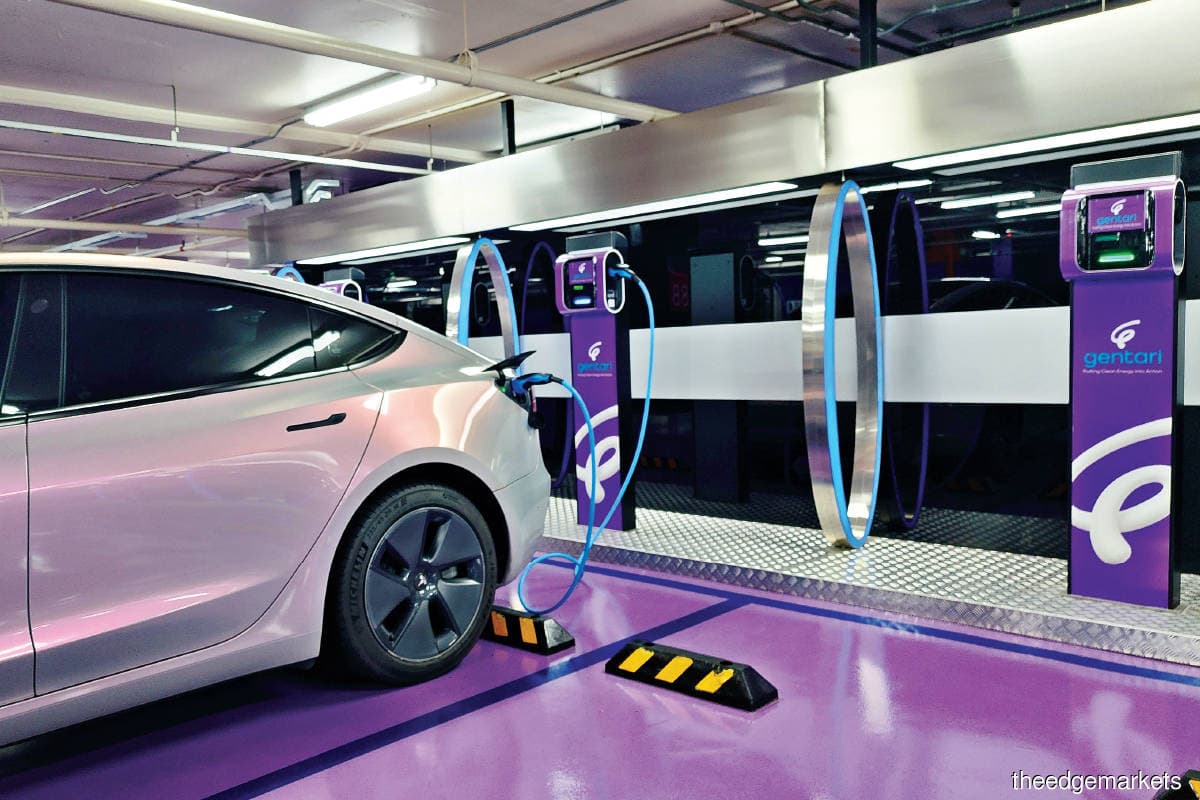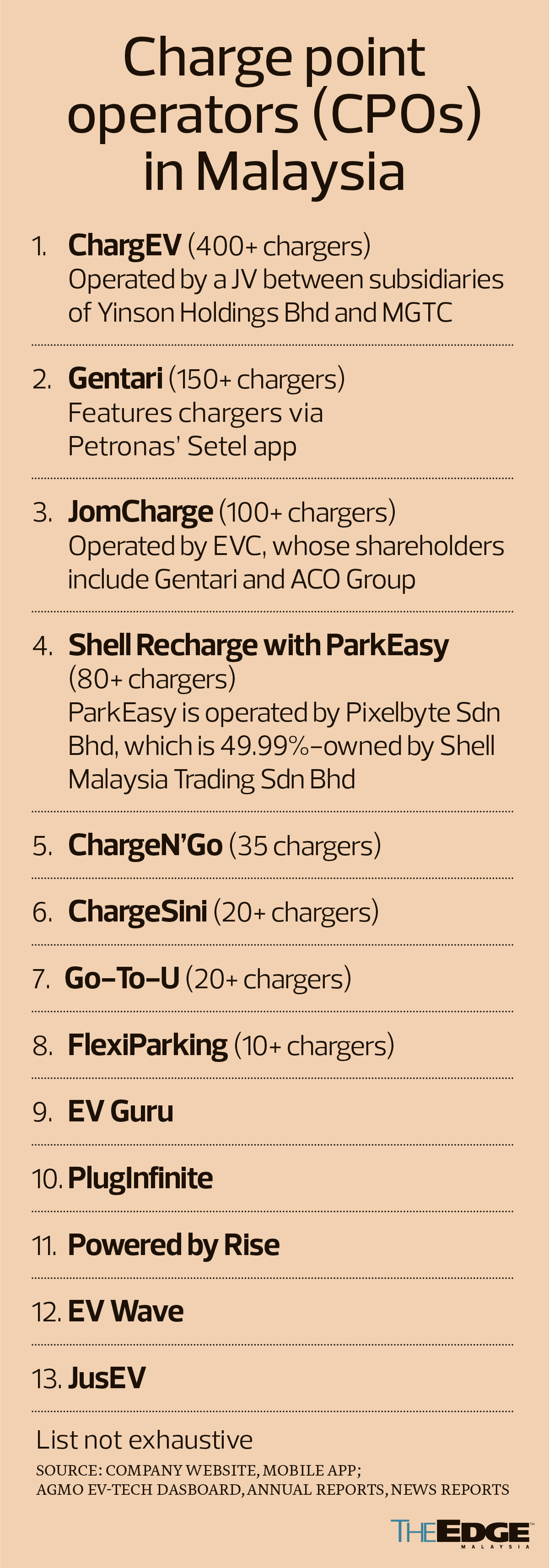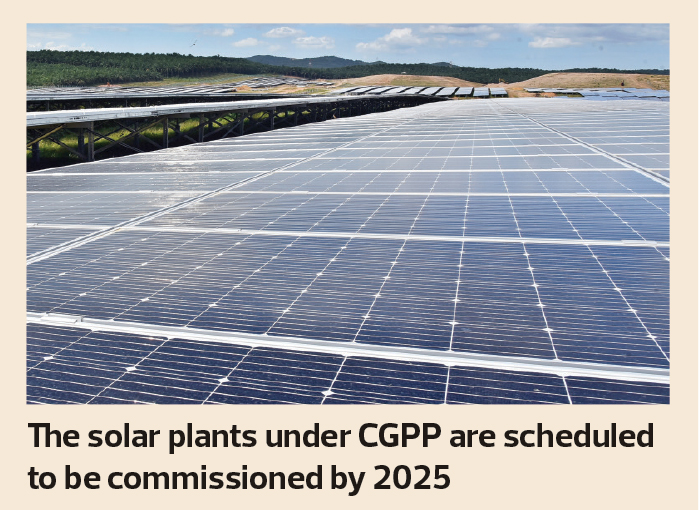
This article first appeared in The Edge Malaysia Weekly on February 13, 2023 - February 19, 2023
AT a corner of Suria KLCC’s premium basement parking lot on level P4 on a Friday afternoon, several electric vehicles (EVs) are seen lined up and plugged into the wall, occupying the on-site charge points.
The building, synonymous with Petroliam Nasional Bhd (Petronas), has 47 charge points installed. This is just one example of the oil and gas (O&G) company’s ambition to focus on clean energy solutions.
Of course, it is very easy to find unoccupied chargers. Still, rising EV adoption is gradually blurring the lines when it comes to selling energy to vehicle users, which was done exclusively via fuel retailers previously.
While Petronas operates more than 1,000 petrol stations in the country via listed unit Petronas Dagangan Bhd (PetDag), less than 40% of the charging stations available via its Setel app are located at petrol stations. The KLCC alone represents 28% of its charge point rollout in the six months since June 2022.
The rest of the charge points — operated by its green energy solutions unit Gentari — are in malls, hospitals and universities, to name a few. It is the same model adopted by another fuel retailer, Shell Malaysia, for its Shell Recharge with ParkEasy network of public charging stations.
Similarly, Boustead Holdings Bhd, which owns an indirect stake in fuel retail brand BHPetrol, launched its first B-Charge network at Royale Chulan Cherating last year, after installing several free chargers at BHPetrol stations back in 2017.
It makes sense as charging takes longer than filling the petrol tank. Hence, it is done while the owner of the vehicle engages in things like work or leisure activities. And unlike fuel, its substitute — electricity — is available almost anywhere, even at home. With an available power outlet, all that is needed is parking space.
The jump in EV sales last year — coupled with these factors — makes the EV charging business all the rage right now, with all kinds of players coming in. Not just the obvious suspects such as national utility company Tenaga Nasional Bhd, energy companies and automotive distributors, but also mall operators and franchise business owners.
Some with prime parking locations choose to ride on the charge point operators’ (CPOs) mobile app solutions. Channel checks show that there are at least 13 CPOs in the country and counting. They include app developers and even electrical contractors who started in the EV business as charger installers and later expanded to providing a mobile app for booking and payment.
The business models include revenue sharing or app surcharge, depending on who bears the cost of installing the charge points.
Competition for space
In terms of the rollout of charge points, Petronas’ Gentari has been the most aggressive, with 151 chargers installed across 70 locations in the last six months.
Gentari’s rollout was partly aided by its partnership with sister companies PetDag and property manager KLCC Property Holdings Bhd. It has also developed Malaysia’s first fast-charging hub at Bangi Golf Resort, followed by another at extreme sports centre X Park Sunway Serene. Gentari is also collaborating with property developers and original equipment manufacturers.
“Our KLCC chargers have three times the normal utilisation rate out there. Since we started, the average utilisation rate across all our chargers has doubled. So, we know we are putting our chargers in the right places,” says its chief operating officer for green mobility Mohamad Haikal Zubir.
A close competitor is ChargEV, which has rolled out more than 400 charge points nationwide since its inception in 2015. Yinson Holdings Bhd has been an indirect majority owner of ChargEV since 2022, with the Malaysian Green Technology And Climate Change Corporation (MGTC) as its joint-venture partner.
“It’s about being early and in the right location. We see 90% of charging happening at home, leaving 10% a public market for CPOs to compete,” says Srinivas Tati, vice-president of business development at Yinson Green Technologies (M) Sdn Bhd.
Some of ChargEV’s partners are Starbucks, hoteliers and BMW distributors.
Others with sizeable charge point counts are JomCharge, operated by EV Connection Sdn Bhd (EVC), and Shell ReCharge with ParkEasy.
It is worth noting that Petronas’ Setel has a partnership with JomCharge. Gentari has a 33.52% stake in EVC, while listed company ACO Group Bhd holds 6.98% via wholly-owned ACO Holdings Sdn Bhd, according to company checks. Meanwhile, Shell Malaysia owns 49.9% of ParkEasy’s operator, Pixelbyte Sdn Bhd.
High capex, slow returns
The EV ecosystem still has a long way to go before it can chip away at the business of traditional fuel stations from which it evolved. It was reported that Malaysia had about 10,000 pure EVs registered, or just 0.04% of the 23 million active vehicles on Malaysian roads.
Due to low utilisation, it has been estimated that up to 10 years are needed to recoup the investment on the chargers. While slow AC chargers are cheap, fast DC chargers (30kW and above) could cost anywhere between RM20,000 and RM200,000, depending on the capacity.
“Apart from traffic, securing locations with available power is a challenge,” says Yinson’s Srinivas. It is more challenging in places like highways, where the construction of new electrical substations and laying of cables could easily add hundreds of thousands of ringgit to the total development cost, say players.
A rule of thumb is that a 120kW DC fast charger installation requires six hours of charging per day to break even in about five years, a rough calculation shows.
For the likes of Petronas and Yinson, it pays to be early as it supports their decarbonisation agenda, given that they have holding power and the cash to splash. ChargEV, for example, has set an internal target to break even in the next five years.
Another big investor is Tenaga, which is tackling the more expensive interstate fast charging segment. “What we want to address in the initial part is range anxiety. We are starting with the highways in collaboration with PLUS [Expressways Bhd] and LPT2 (Lebuhraya Pantai Timur 2 Sdn Bhd), and we plan to install the chargers on major trunk roads next,” says Tenaga’s EV PMO project director Mohd Junaizee Mohd Noor.
For that, Tenaga is open to partnering site owners such as petrol stations. “At this point, the industry is still at a nascent stage. We don’t consider the other parties as competitors, but more as partners, because we want to work together to ensure there are enough chargers for long-distance EV travellers,” he adds.
In theory, any form of growth in the EV ecosystem is good for Tenaga, considering that it is the sole electricity transmitter and generates half of the power in the country. Just like Gentari, the utility giant — via TNB Energy Services Sdn Bhd — has built “electron stations” with dual fast charge points in Ayer Keroh, Melaka, and Paka, Terengganu.
Booming installation segment
For smaller players, the increasingly crowded and small market poses a new challenge to compete for prime, high-traffic commercial locations.
But ambitious infrastructure rollout targets across the industry, led by the Malaysian government’s target of 10,000 public charge points by 2025, translate to a booming business for the installers of chargers.
Gentari has a short-term target of 500 chargers online by the end of this year, while ChargEV aims to have 4,500 chargers by 2030. Tenaga has earmarked RM90 million to install up to 70 DC fast chargers nationwide by 2024.
The market is willing to spend. Bursa Malaysia-listed app developer Agmo Holdings Bhd, which recently launched its EV Dashboard, has seen major CPOs sign up as they are keen to use its granular data to plan future installations.
“They can make informed decisions on how many charging stations are needed and where they should be strategically located. This helps optimise costing and maximise their return on investment,” says Agmo CEO Tan Aik Keong, adding that the platform is generating subscription revenue.
Apart from public charger installations, installers also benefit from home charging, where the bulk of the charging takes place at a cheaper electricity tariff and is usually done overnight.
Other CPOs in the market backed by installation expertise include Go-To-U Malaysia, EV Guru and ChargeSini.
Among the listed companies that have ventured into this space are Solarvest Holdings Bhd, via PowerBee, and Pestech International Bhd, which operates CPO brand PlugInfinite. Other notable names include Carput and VSD Automation Sdn Bhd. The latter says it has helped CPOs install hundreds of chargers in the last few years.
The road ahead
For now, almost anyone can be a CPO. The Energy Commission (EC) regulation requires competent contractors for installation, while the equipment only needs to adhere to international standards.
“It is the government’s policy to have 10,000 public charge points by 2025, and the regulator is supporting that policy,” says EC CEO Datuk Razib Dawood in a brief response when contacted.
Open Charge Alliance, the international body that promotes open charging, develops standards such as the Open Charge Point Protocol (OCPP) to ensure interoperability of an EV charger and the software involved for real-time assessment. That said, the adoption of OCPP criteria by CPOs is on their own initiative. There is no actual standardisation in the market.
As demand for petrol — estimated at 17 billion litres a year — is being slowly substituted with electricity, the load management capabilities across the chargers, which influences the stability of the grid, will be something that regulators will have to watch closely.
There is some optimism in the mobility electrification pathway, as more EVs are being brought into Malaysia, including by local automaker Proton Holdings Bhd, this year. Several new apartment projects have been promoted as being “EV charger-ready”, as developers plan to lay the cables and provide the isolators to each and every parking lot.
In the long term, players like Gentari, ChargEV and PowerBee are targeting the conversion of transport fleets owned by commercial consumers as part of their green mobility business strategy. This could boost adoption.
The government has also hinted at more EV-related incentives in the upcoming Budget 2023. Some are hopeful of incentives for EV charging hardware and support for companies involved in the segment, as well as an extension of the tax holiday for EVs.
Meanwhile, the Malaysian Electric Vehicle Owners Club has proposed to the government to allocate RM30 million from Kumpulan Wang Amanah Dana Automotif Bumiputera to support the next wave of charging infra deployment, such as to cover the cost of substations at rest and service areas along the busiest highways.
Still, Malaysia’s 2022 EV sales represented just 0.37% of total industry volume of 720,658 units, compared with 1.5% in Thailand (which would be higher when EV motorcycles are included), and 9.5% of the global tally in 2022. Of the 10,000 EVs on the road in the country as at the end of last year, 2,631 units, or 26%, were only purchased in 2022, Malaysian Automotive Association data show.
Demand is still fragile, as witnessed last month in Germany, where its government’s decision to scale back incentives caused a drop in EV and hybrid vehicle sales, while sales of internal combustion engine (ICE) vehicles rose.
“Based on other markets, industry consolidation will begin when EVs take up 25% of new vehicle sales,” says Yinson’s Srinivas.
Another industry player thinks that it will take five years for the EV market to reach a level that allows the public EV infrastructure business to be more viable. “More players will come in. But not everyone will make money. It is not like fuel retailing. It is an entirely different thing,” he says.
Save by subscribing to us for your print and/or digital copy.
P/S: The Edge is also available on Apple's App Store and Android's Google Play.




